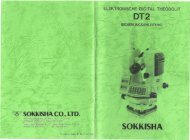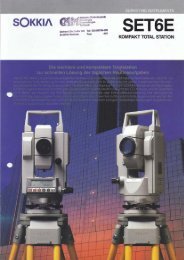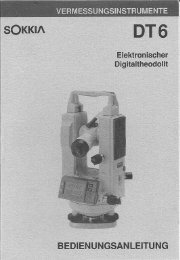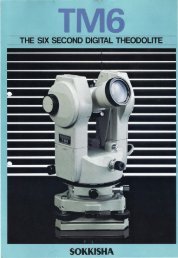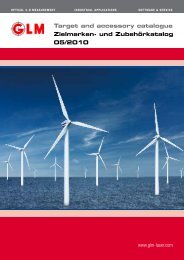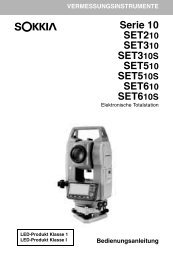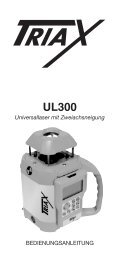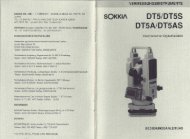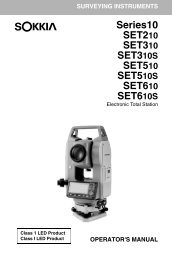SDL1X White Paper - Glm-laser.com
SDL1X White Paper - Glm-laser.com
SDL1X White Paper - Glm-laser.com
- No tags were found...
You also want an ePaper? Increase the reach of your titles
YUMPU automatically turns print PDFs into web optimized ePapers that Google loves.
DIGITAL LEVEL<strong>SDL1X</strong>TECHNOLOGY FRONTLINE
<strong>SDL1X</strong> OverviewThe <strong>SDL1X</strong> was developed with two priorities in mind: highprecision and stress-free operation.In precision, measurement with a BIS30A staff yields astandard deviation of 0.2mm for 1km double-run levelingconforming to ISO 17123-2. Several details support thishigh-precision measurement. The RAB-code level staff hasthermal coefficients of expansion that are close to zeromaking it highly resistant to changes in ambienttemperature. The <strong>com</strong>pensator is extremely reliable, and thelevel's auto focus is designed to provide the sharpestbarcode image to the image sensor every time. For easieroperation, several new features alleviate the stress ofsurveying in various ways, which in turn supportshigh-precision measurement and reduces the need forremeasurement. These features and related user benefitsare summarized in the following table.Table 1. <strong>SDL1X</strong> features and user benefitsFeatureUser BenefitExternal designOptimized image sensor controlAuto focusView finderRemote triggerDual-axis tilt alarmWide range of interfaces,built-in softwareNew Super InvarRAB-Code Staff BIS30A1. External designThe <strong>SDL1X</strong> inherits SRX design concepts: outdoor-readyyet refined. The stable, wide body and reassuring controlpanel support high-precision measurement and are veryeasy for novice surveyors to use.2. CompensatorBetter Usability(Less Stress)Better Precision Better Outdoor(Eliminates Errors) PerformanceBetter SurveyingEfficiency (Faster)A hallmark of Sokkia levels is the pendulum <strong>com</strong>pensatorwith a magnetic damping system. This <strong>com</strong>ponentmaintains excellent measurement reproducibility whilereducing the control period until the pendulum stopsmoving, for consistent precision.3. RAB code and measurement softwareAnother example of original Sokkia technology in the <strong>SDL1X</strong>is the highly reliable RAB-code pattern on the staff. We havemaintained the same coding system in the RAB-codepattern since our digital levels were first introduced. For thisreason, new and old Sokkia staves and levels (which run thebuilt-in measurement software) are inter<strong>com</strong>patible.4. Optimized image sensor controlThe image sensor functions both in height measurementand auto focusing. We have optimized image sensor controlby making significant revisions to the existing technology.This enhances the SDL series' acclaimed stability andmeasurement while improving outdoor performance andaccelerating measurement.5. Auto FocusPolished measurement performance, <strong>com</strong>bined with swiftfocusing motion, affords better usability. Auto focus locksonto the Sokkia RAB-code staff, not other objects,providing the sharpest barcode image to the image sensorfor the ultimate in measurement precision. This representsthe world's first use of auto focus in this class of digital level.6. View finderThe "view finder" is a collimation telescope that helps ensureconvenient and efficient auto focusing, and fast, accuratecollimation.7. Remote triggerAn IR remote trigger is provided. Use the dedicated DLC1remote trigger to perform all steps from the start ofmeasurement until recording without touching the level.Touching the level may lead to unintentional movement, andas a result, inaccurate results.8. Dual-axis tilt alarmPrevious digital levels only detect tilt along the collimationaxis, but the <strong>SDL1X</strong> provides a more reliable detectionmechanism that also alerts users if the unit is tilted relativeto the transverse axis. Audible notification of tilting, inaddition to graphical representation of the leveling status,greatly facilitates the process of leveling.02
9. Wide range of interfaces, user-friendlybuilt-in softwareThe level offers many ways to efficiently transfer observationdata for post-processing. Save data internally on the <strong>SDL1X</strong>or on storage media—USB flash drives or SD cards. Forconnectivity with <strong>com</strong>puters or portable devices, bothBluetooth ® and RS-232C are available. A critical point ofcontact with users during operation, the built-in softwaredisplays instructions to guide users through themeasurement process. An easy-to-use row of soft keys,plentiful configuration functions, and other touches create auser-friendly interface for stress-free operation by any user,regardless of nationality.10. RAB-Code Staff BIS30A(made of New Super Invar)To date, the Sokkia New Super- Invar Staff GS-1 hasboasted outstanding reliability for optical levels. Nowupdated with RAB-code graduations, the New Super InvarRAB-Code Staff BIS30A has the world's lowest linearexpansion coefficient (see below). BIS30A is an ultrahigh-precision staff that unleashes the full potential of the<strong>SDL1X</strong>.α = ±0.1x10 -6 /°C (±0.1ppm/°C)03
External DesignThe subdued <strong>SDL1X</strong> color scheme, produced withenvironmentally-conscious water-based paint, follows in thetradition of SRX coloring. The refined shape <strong>com</strong>binesangular contours and graceful, smooth surfaces. At thesame time, a wide range of features are packed into the<strong>com</strong>pact body, and design supporting high-precisionmeasurement is evident in many details. Weight is evenlydistributed to enhance machine accuracy. Uneven weightdistribution would impair machine accuracy, even ifperpendicularity of the rotation axis was good. For thisreason, balanced weight distribution is ensured, accountingfor the weight of each internal module, in a design thatbrings the center of gravity extremely close to the rotationaxis.The new view finder, housing the optics, is a fresh twist onthe familiar telescope of surveying levels. The optics areintegrated into the handle with an open space left betweeneyepiece between eyepiece and objective. Aside from beingan original design, this construction places the peep sight ina more convenient position, supports long-range viewing,and keeps the unit more <strong>com</strong>pact.Figure 2. Body design: sketch, CAD drawing,and final design modelFor high-precision measurement, a remote trigger isindispensable. This enables users to initiate measurementwithout touching the level. Because the remote trigger isvirtually an extension of the operator's own body, it wasdesigned to be a size and shape that fits in one hand as theoperator controls the level. The keys are optimallypositioned and a minimum number of keys are used,enabling control without looking. The DLC1 remote trigger<strong>com</strong>bines all of these characteristics for superb usability.Figure 1. Sketch and CAD drawing of the view finderTwo points were intentionally revised from the previous SDLseries. First, fine motion knobs were repositioned from theobjective side to the eyepiece side. Because the body isnow wider, the knobs were moved closer to the operator foreasy access. Additionally, organizing control panel elementsat the operator side simplifies operation and enhancessurveying efficiency. Second, the focusing knob is nowmore flush to the body. Given the unit's new auto focus, thisdesign decision makes sense considering how infrequentlythe knob is are used. Desirable aspects of the previous SDLseries were retained, such as the arrangement of themeasure key close to the rotation axis and an ample lenshood to prevent ambient light from impairing precision.Figure 3. Remote trigger design: sketch,CAD drawing, and final design model04
2Automatic Compensator3The level's <strong>com</strong>pensator can be described as a pendulumsystem. Gravity brings the pendulum on which a mirror issuspended into horizontal equilibrium. Because magnetismis used to rapidly dampen the pendulum, we refer to thismechanism as magnetic damping. Damping is rapid, but noundue force is applied. The appropriate force for magneticdamping is reflected in the design, for a <strong>com</strong>pensator withsuperb leveling reproducibility (see Figure 4) and a shortdamping time after collimation until the pendulum is still (seeFigure 5).The pendulum itself is made of highly antimagnetic material,preventing residual magnetism. As a result, the <strong>com</strong>pensatoris not affected by magnetism despite employing magneticdamping.Height measurement (m)Measurement distance: 50 mMeasurement mode: single measurement, auto focus ONS/N 100005 : = 0.046mm (0.19” )S/N 100006 : = 0.049mm (0.20” )1.58541.58531.58521.58511.58501.58491.58481.58471.58461.58451.58440 2 4 6 8 10Number of measurementsRAB Code andMeasurement SoftwareUsing a built-in image sensor, the digital level reads patternson the staff. Highly exact values can be calculated for thecollimation position (height). The pattern printed on the<strong>SDL1X</strong> staff is a digital barcode, with the width of eachblack line representing one element of code (one symbol).At close range, fewer lines of barcode are read, but thesubtle difference in line width is detected. The acquiredimage is converted to a six-element code. At a greaterdistance, the opposite applies: more lines are read, butbecause the resolution is lower, subtle differences in linewidth are not discernable. Thus, the acquired image isconverted to a three-element code. The widths of blacklines and corresponding RAB code are shown in Table 2.Because this code system enables identification of thecollimation position with as few elements of code aspossible (based on conversion in Table 2), correctmeasurement is possible even when the staff is partiallyconcealed or in the shade, preventing some code frombeing read. The level automatically distinguishes betweenstaves held right-side-up and those inverted.Black line width(mm)34781112Table 2. RAB code conversion tableSix-Element Code(at close range)012345Three-Element Code(at a distance)012Figure 4. Reproducibility data for height measurement(Rotated 360° horizontally for each measurement)Measurement distance: 10 mMeasurement mode: Rapid-repeat measurementHeight Tilt-X Tilt-Y1.000520161.00001280.9995400.9990-4-80.9985-12-160.9980 -20-2 0 2 4 6 8 10 12 14In operation/collimationDamping Pendulum stillTime (s)Height measurement (m)Figure 5. Time after pendulum damping until stillnessDual-axis tilt sensor( ’)The black lines are evenly spaced, relative to the middle ofeach line. This pitch between lines is used in electronicmeasurement of stadia distance, enabling highly precisemeasurement of distance to the staff.Moreover, the measurement software processes each blackline separately. This eliminates overall miscalculation if somelines cannot be read and makes it possible to obtain thecollimation position from the remaining information.In this way, both the barcodepattern and measurementsoftware have been developedto make measurement lesssusceptible to the effects ofshading or interference. Wehave maintained this approachsince 1998 when the SDL30was introduced, and thesystem is used for staves withall SDL models (SDL30,Figure 6. RAB-code pattern SDL30i, SDL50, and <strong>SDL1X</strong>).05
4Optimized Image SensorControlUsing auto focus under lighting conditions subject tosudden changes requires sophisticated and speedy imagesensor control. Control system requirements in bothhardware and software were designed to allow optimizedimage sensor control. The result is superior measurementperformance, because the RAB-code pattern is read underoptimal conditions whether the staff is viewed in brightsettings (such as against the sunset) or under uneven light,as when light filters through branches in a forest. Thisoptimization of image sensor control ensures consistentauto focusing not only in response to environmental factorsbut also accounting for movement of the focusing lens.51. ConceptWith most traditional digital levels, sighting and focusing onthe staff are tasks that depend on visual determination bythe operator peering through the eyepiece lens. Focusingtherefore involves an elemeny of error. Once measurementresults are obtained, however, it cannot be determinedwhether the effect of this error has been accounted for. Justhow much this error can be reduced (at what point is theinstrument perfectly focussed) depends on the judgment ofthe operator.For this reason, the <strong>SDL1X</strong> is designed to provide theoptimal focal conditions the sharpest barcode image, for theimage sensor at all times, eliminating human error infocussing. Moreover, we have also addressed problems ofexisting auto focus functionality: focus is accidentally set atthe wrong point; confusing; time-consuming; stressful forobservers. Sokkia’ s auto focus eliminates these problemsto the greatest degree possible, for easy and stress-freeoperation.2. PrincipleAuto FocusA passive method of auto focusing is employed by the<strong>SDL1X</strong>, <strong>com</strong>bining electronic stadia measurement andcontrast detection. It can be described as passive because,unlike active auto focus involving auxiliary lighting or adistance measurement beam independent of the telescopeoptics, no such lighting source is used. Instead, imagescaptured by the image sensor are the sole basis fordetermining focus.The sequence of auto focus control is shown in Figure 7.When the stadia distance is calculated electronically, theeven spacing of RAB code determines whether the object ofcollimation is a RAB-Code Staff, and the general distance tothe staff is calculated.Next, from the general distance, the lens position for idealfocus is calculated, and a method of detecting contrast nearthe lens position is employed to determine the optimalfocusing position for the image sensor.StartElectronic measurementof stadia distanceDistancemeasurementfinished?Complete rangesearch finished?(Search continues)No staffFocal point detectionfinished?This <strong>com</strong>bination of electronic stadia measurement withcontrast detection prevents the <strong>SDL1X</strong> from mistakenlyfocusing on objects other than RAB code, eliminatesconfusion in operation, and creates optimal focusingconditions for the image sensor. The result: truly ideal autofocusing with no human error during measurement (seeFigure 8).1.54151.54141.5413General focusingposition calculatedSearch range for contrastdetection determinedContrast detectedTimeout?(Searching continues)(Performed while moving lens)TimeoutFocal point confirmedIn focus?Out of focusFigure 7. Auto focus control flowRange determining lensposition during auto focusRange determining lens position duringmanual focus (based on Sokkia research)Height measurement (m)Focusing finished1.54122200 2250 2300 2350 2400 2450 2500 2550 2600 2650 2700Focusing lens position (μm)Figure 8. Variation in height measurement resultsdepending on focusing lens position (distance: 30m)06
3. StructureThe <strong>SDL1X</strong> auto focus mechanism is shown in Figure 9.The data acquisition section of the image sensor capturesdata both for auto focusing and height measurement.The focusing lens position detection section supports aninnovative method for detecting the absolute position of thefocusing lens directly (patented). It is carefully constructed toavoid affecting movement by the focusing lens tube.This detection section feeds back the exact position of thefocusing lens to the enabling fast, exact position control ofthe focusing lens. A valuable feature of this function is thatthe focusing lens position is not returned to the origin whenthe level is powered on or when manual focus is usedduring leveling. Rotation of the focusing knob shaft isconverted by the rack-and-pinion mechanism to areciprocal motion for the focusing lens. The focusing knob isdirectly attached to the focusing knob shaft allowing themanual focus of previous models. On the other hand, thefocusing lens drive section used for auto focus is connectedto the focusing knob shaft via a friction clutch. During autofocus, it is through this clutch that the drive section movesthe focusing lens. Another advantage, from the point of viewof ease-of-use, is that this structure renders a switchingoperation between manual focus and auto focusunnecessary.Manual focusing knobFocusing knob shaftFriction clutchFocusing lens drive sectionReduction gearRack-and-pinion mechanismRotary encoderDC motorImage sensor data acquisition section(also acquires height measurement data)Objective lensFocusing lens tubeFocusing lens position detection sectionLight-emittingelementLight sensorFocusing lensCompensatorEyepiece lensReticleBeam splitterFigure 9. Auto focus mechanism07
View finder6The view finder is a small scope (3° field of view, 4.5xmagnification) that supports accurate sighting of the staffprior to focusing, allowing smoother operation of thesubsequent auto focus and measurement stages as a result.As a fixed-focus scope set at 50m, it requires no focusing.The optical design provides long eye relief, eliminating theneed to bring one's eye close to the instrument whensighting, making the view finder easy to use for operatorswho wear glasses.These characteristics contribute to a higher magnification,and therefore greater collimation precision, than that of mostgun sights (peep sights). What's more, quick sighting of thestaff is made easier as the field of vision is wider than that ofthe level's telescope and there is greater eye relief at theeyepiece.As shown in Figure 12, the view finder reticle image consistsof four concentric circles. The outer pattern corresponds tothe field of vision of the level telescope (1˚ 20’ ). Thediameters of the three patterns within this correspondroughly to the width of RAB code bar (22mm) when sightingan invar staff 50m, 25m, and 10m away, outward from theinner circle.1˚ 20’ circle(range of telescope’s field of view)Reticle patternEnlargement ofcenter portionDiameter fora staff at 50mDiameter fora staff at 25mDiameter fora staff at 10mFigure 12. View finder reticle imageFigure 10. Sighting with the view finderAs shown in the cross-section (Figure 11), the view finder isseparated into two sections <strong>com</strong>posing opposite ends of theinstrument handle, one unit on the objective side and one uniton the eyepiece side. In front of the objective lens is anadjustment mechanism <strong>com</strong>prising a pair of glass wedges.These wedges are used to align the view finder's telescopeaxis with that of the level’s telescope, and are adjusted bymeans of the view finder axis alignment screw on theobjective side. The view finder image is brought into focus bymeans of an view finder eyepiece screw on the eyepiece lensside. In either case, adjustment is easy for users. (patented,design registered)View finder axis alignment screwView finder eyepiece screwReticleGlass wedges Objective lensSighting directionErecting prismView finder eyepiece lensFigure 11. View finder cross-section08
7Wide Range of Interfaces8and Built-in SoftwareThe <strong>SDL1X</strong>'s software is organized into three menus, asshown in Figure 13: Measurement, Management, andConfiguration. Height difference measurement in theMeasurement menu enables measurement in accordancewith a preset measurement procedure and user-specifiedtolerance values. Seven measurement procedures areavailable (BFFB, BBFF, BF, aBFFB, aFBBF, BFBF, andaBF), as are a variety of detailed settings such asmaximum/minimum distance limits and upper/lowertolerances on height readings. The step-by-step instructionson the instrument screen and the preset tolerances allowthe user to keep track of results at each stage ofmeasurement.Additionally, a pre-measurement function is available ateach instrument position before the actual measurement isbegun to confirm that distances to the foresight andbacksight are roughly the same. As precise leveling of theinstrument is not necessary at this preliminary stage, the tiltwarning is temporarily disabled. This pre-measurementenables confirmation of the instrument position, and cansave time when relocating to correct an error, therebypromising better working efficiency.The Route option in the Management menu enables routeconfiguration, deletion, data exporting, and data review. Inroute settings, up to five configuration patterns (measurementprocedures and tolerances) can be pre-set, making it easierto create route settings data under preferred or often-usedconditions. Route data can be transferred via the serial port(RS-232C) or via Bluetooth ® , or saved on a USB flash driveor SD card.New Super InvarRAB-Code Staff BIS30AIn measurement with digital levels, a key factor determiningmeasurement precision is the precision of the staff. Attaininga 0.2mm standard deviation for 1km double-run leveling withthe <strong>SDL1X</strong> therefore meant we needed to develop a newstaff. This new RAB-Code staff, BIS30A, has highly precisegraduations with a coefficient of linear expansion of nearlyzero.The band on which graduations are printed is made fromNew Super Invar. This special alloy has a negative linearexpansion coefficient. One end of the graduated band isattached to an anchor at the bottom of the staff’s aluminumouter frame, and the other is attached to the same frameindirectly, through a coil spring (see Figure 14 below).The outer frame and coil spring together have a positivecoefficient of linear expansion, and offsetting the springconstant and coefficient of negative linear expansion of theband yields a negligible linear expansion coefficient forgraduations overall.Coil springGraduated band(New Super Invar)Outer frame(aluminum)Main menuMeasurementHeight DifferenceMethodCheck &AdjustmentManagementJOBRouteAnchor pointConfigurationFigure 13. <strong>SDL1X</strong> application menu structureFigure 14. Structural diagram of BIS30A09
Specifically, the structure responds to increases intemperature as follows. Because New Super Invar has anegative linear expansion coefficient, the graduated bandcontracts under higher temperatures. In contrast, thepositive linear expansion coefficient of the outer framecauses the frame to expand. The result is that the tension ofthe aforementioned coil spring increases and stretches thegraduated band. The contractive force is balanced by thistension, maintaining a constant length in the graduatedband. Because the coil spring tension, and therefore theforce exerted on the contracting band, can be adjustedusing the spring constant and the total spring length, wehave been able to develop a linear expansion coefficient forgraduations () that conforms to the following equation. = ±0.1x10 -6 /°C (±0.1ppm/°C)High graduation precision requires highly precise positioningof the RAB-code pattern in which graduations are printed.The boundary of each black line must be flat on the surfaceand free of any kinks or distortion. To ensure superiorpositioning precision when etching on to the band, a lengthgauge (<strong>laser</strong> interferometer) is used to <strong>com</strong>pensate forenvironmental changes in real time when determining theposition of each graduation. As a result, the correction valueor discrepancy representing positioning precision is within20µm of graduation design values per meter. Additionally,special coatings and Sokkia <strong>laser</strong> etching techniques areused to produce RAB-code patterns that are clear and haveexact boundaries.9World's highest precision: 0.2 mm(standard deviation for 1 km of double-run leveling)The technology introduced in this brochure has pushed theboundaries of measurement precision in the <strong>SDL1X</strong>. The<strong>SDL1X</strong> inherits the advances made in preceding SDLproducts while reducing the scope for error further still thanksto the superb leveling reproducibility achieved with theautomatic <strong>com</strong>pensator and higher measurement precisionachieved with auto focusing.A <strong>com</strong>bination of superior materials and innovative staffconstruction has minimized linear expansion, eliminatingerror derived from ambient temperature fluctuations duringmeasurement. Moreover, exceptional precision in graduationprinting translates directly into better measurement precision.Scientific theory and practical experience have enabled us toachieve a satisfying level of precision faced with the errorfactors mentioned above. We have confirmed an accuracy ofwithin 0.2mm per km (double-run leveling) using both ISO17123-2 evaluation standards and actual measurement.10
ConclusionIn leveling, the level and staff are moved, in turn, to determine relative elevation along a route. The operator needs toconcentrate when sighting and focusing on the staff, with extended periods of work leading to fatigue. Such stress can begreatly alleviated by using the level's newly developed view finder and auto focus features, which also improve the measurementprecision and produce more consistent results. What's more, auto focus works exclusively on staves with RAB code,eliminating errors in collimation or accidental reading of staves with other barcode. These advances enable more efficient workin the field.The SDL30i was developed based on the SDL30, a model widely used in measurement work. Like previous models,the <strong>SDL1X</strong> promises to be a popular instrument not only in surveying but in other measurement applications as well, thanks toits high-precision measurement and the convenience of auto focus. The <strong>SDL1X</strong> was developed incorporating the besttechnology used in applications from optical levels to total stations, and it will contribute significantly to higher precision andgreater efficiency in leveling.ReferencesJournal of Applied Surveying Technology, Vol. 9,pp. 27–34, Japan Association of Surveyors (1998)Handbook of New Surveying Instruments,Japan Surveying Instruments Manufacturers' Association (2003)11



